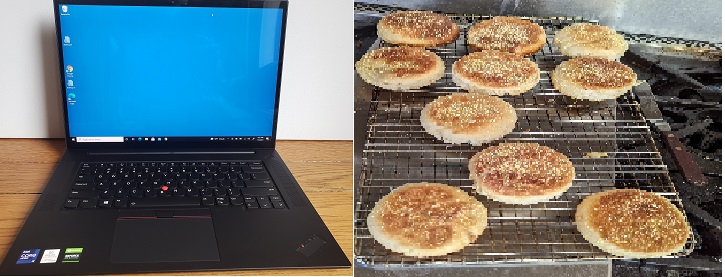Deli Rye Bread
This makes a bread similar to what you would get from a Jewish bakery in New York, or some similar location. The difficult thing is finding the 2 types of flour that are used. Most rye flour is called “dark rye”, and one might suspect that light rye (also called white rye) is a different grain. Actually, the relationship between light and dark rye flours is similar to the relationship between white and whole wheat flour. Light rye and dark rye are both finely milled, but light rye has had the germ and bran removed before milling. Light rye flour can be found on the internet. Light rye, like white flour, has no germ, therefore no fat. No fat means there is nothing to go rancid, so if you need to buy in a large quantity, it has a long shelf life and does not require refrigeration. High-gluten flour can also be found on the internet, but I buy it at a warehouse-type store that also sells to restaurants and bakeries. The type I get comes in 25 or 50 lb. bags, but smaller quantities are available online. This is the type of flour that you would also use in pizza or bagels. You want something with at least 14% protein (gluten),
I have a stand mixer that will easily deal with 10 cups of flour. If you have a smaller, 5- or 6-quart model, you can cut down the size of the recipe, as long as the ratio of liquid to flour remains the same. The weight of the water should be about 59% of the total weight of the flours. (The rye does not absorb as much liquid as the white flour.) There should be about 3 ounces of high-gluten flour for every 2 ounces of light rye. If I were using a 5-quart mixer, I would make 2/3 of the recipe.
Sponge
2 Pounds russet or other high-starch potatoes to yield 8 oz potato water
5 oz (1 cup) Light rye (white rye) flour
Pinch of Yeast
¼ t Honey
Loaves
22 oz. Warm water
About 2 t Honey (0.3 oz.)
5 t Kosher salt (see note: salt notes )
I oz. (about 4 T) Caraway seeds
31 oz. High-gluten flour
15 oz. Light rye flour
Caraway seeds, as needed (optional)
Glaze
½ Cup water
1 T Cornstarch or Potato starch mixed with ¼ cup of cold water
Start 3 or 4 days ahead. Peel and cut the potatoes into chunks. Cover with bottled or filtered water and cook as if you were making boiled or mashed potatoes, but do not salt the water. Salted water will inhibit bacterial growth needed for fermentation. Save the water and keep the potatoes for another use. After the water has cooled to lukewarm, put 8 oz. (one cup) into a bowl. Add 1 teaspoon of dry yeast and allow the yeast to activate. Add the honey. Stir in one cup of light rye flour. Cover tightly and set the bowl aside for about 4 days. Any remaining potato water can be divided into batches and frozen for later use.
After the time has elapsed, stir in the water, honey, caraway seeds and salt. Stir in the flours. Knead the dough for about 15 minutes by hand, or an equivalent time if using some sort of machine. If you are making pumpernickel in a machine, it will take longer than you might expect before it cleans the bowl. Cover and put the dough into a warm place for about 1 ½ hours. Check after an hour to see if it is fully risen. Punch the dough down and allow it to rise again for 15 minutes. Divide the dough into 3 or 4 portions; knead each part, and form into free-standing loaves. If the loaves feel too wet, add bench flour to make them sturdy enough so that they do not spread out too much to the sides as they rise and bake. Put the loaves onto a baking sheet. If you want caraway seeds on the outside, spray the loaves with a little water and sprinkle the seeds over them. Cover the loaves and put loaves into a warm place for about an hour. Check after about 40 minutes; do not let them over-rise.
If you have the ability to generate steam, spray 3 or 4 times over the first 10 minutes and skip the instructions related to the pan of water.
Place a pan on the floor of the oven and preheat it to 425º. If using a convection oven, the temperature should be set to about 400º. (The actual adjustment will depend on your particular oven.). Slash each loaf deeply in 3 places. Put some boiling water into the pan and put the loaves into the oven. Bake the bread for about 30 minutes (check after 27), removing the pan of water after about the first 10 minutes. If you make 4 loaves, rather than 3, you will need to reduce the baking time by about 3 minutes. You should rotate the baking sheet after about 2/3 of the baking time. While the loaves are baking, make the glaze. Bring the ½ cup of water to a boil. Stir in the starch slurry and allow it to thicken. As soon as the loaves have baked, move to a wire rack and immediately brush with the glaze while the loaves are still hot.
